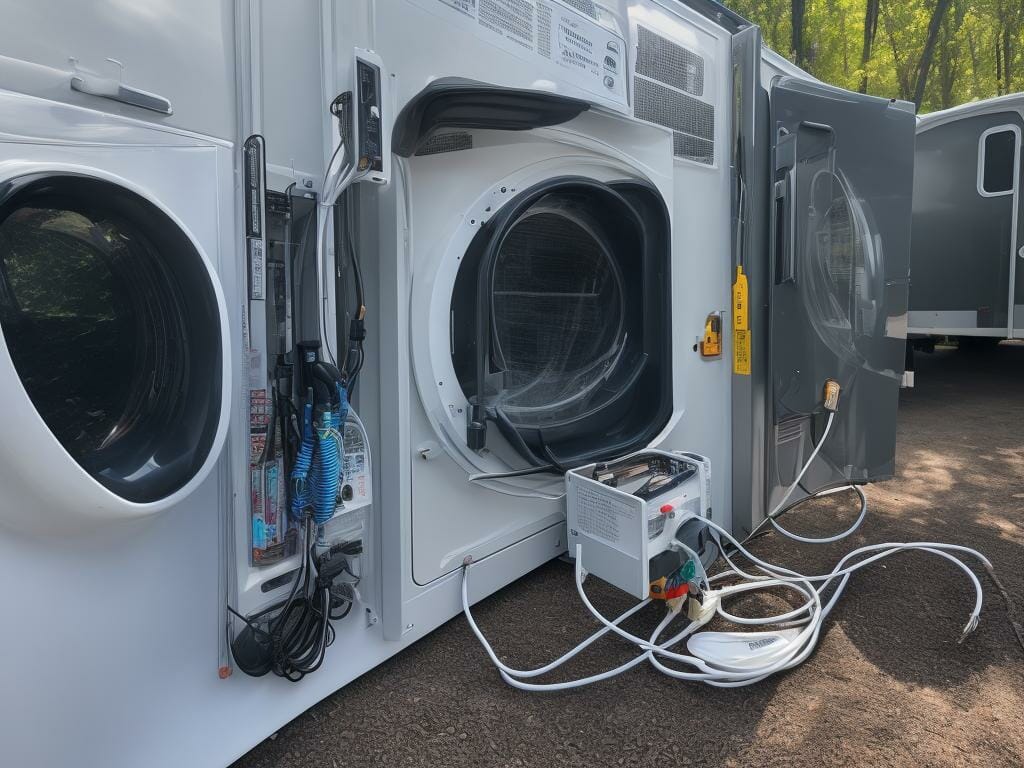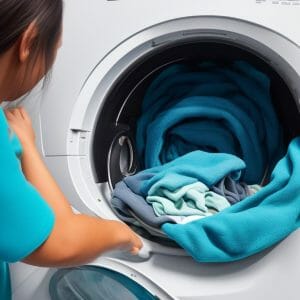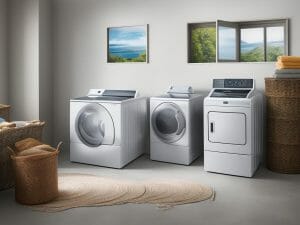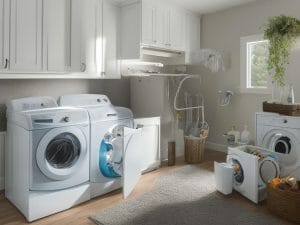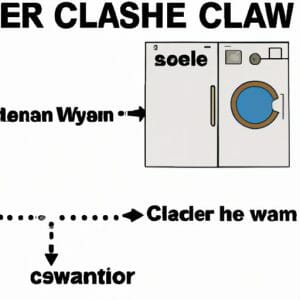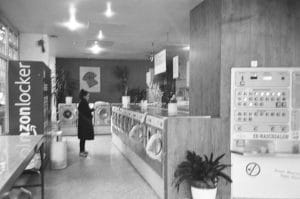Connecting Your RV Washer and Dryer to Water and Electric
Do you dream of doing laundry on the road, effortlessly washing and drying your clothes in the comfort of your RV? Well, buckle up, because connecting your RV washer and dryer to water and electricity is about to become as smooth as a coastal drive.
In this article, we will guide you through the process step by step, ensuring that you have the power and water connections you need to keep your clothes fresh and clean while you enjoy the freedom of the open road.
Key Takeaways
Determining the Power Requirements
To determine the power requirements for connecting your RV washer/dryer to water and electric, you’ll need to check the manufacturer’s specifications. When choosing appropriate appliances for your RV, it’s important to consider their energy consumption. This will help you ensure that your RV’s electrical system can handle the power needs of the washer/dryer.
Start by calculating the energy consumption of the appliances. Look for the wattage or amperage ratings provided by the manufacturer. Multiply the wattage by the number of hours you plan to use the appliances each day to determine the energy consumption in watt-hours.
This will give you an idea of the power requirements and help you make an informed decision when selecting an RV washer/dryer that suits your needs and can be safely connected to your RV’s electrical system.
Connecting the RV Washer/Dryer to an Electrical Outlet
Make sure you plug the RV washer/dryer into an electrical outlet that can handle the power requirements. When connecting the RV washer/dryer to an electrical outlet, it is crucial to follow best practices for RV washer/dryer maintenance.
Firstly, ensure that the outlet is compatible with the power requirements of your washer/dryer. Check the user manual or consult a professional for the specific voltage and amperage needed.
Secondly, consider using a surge protector to safeguard against power fluctuations and prevent damage to the appliance.
Additionally, if you plan to use a generator to power your RV washer/dryer, make sure it is capable of supplying the necessary electricity. Consult the generator’s manual and verify that it meets the power requirements for your washer/dryer.
Following these guidelines will help ensure the safe and efficient operation of your RV washer/dryer.
Understanding the Water Connection Options
When setting up the water connection for your RV washer/dryer, be sure to understand the different options available. Here are three important considerations to keep in mind:
Installing the Water Supply Lines for the Washer/Dryer
Ensure you have the necessary materials and tools before beginning the installation of the water supply lines for your washer/dryer.
To properly connect your washer/dryer to the water supply, you will need the following items: a set of braided stainless steel hoses, Teflon tape, an adjustable wrench, and a water shut-off valve.
Start by turning off the main water supply and disconnecting any existing hoses.
Next, attach the new braided hoses to the water supply valves, ensuring a tight connection.
Apply Teflon tape to the threaded ends of the hoses to prevent leaks.
Connect the other end of the hoses to the corresponding inlet valves on the washer/dryer.
Once everything is securely connected, turn on the water supply and check for any leaks.
It is important to check the water pressure and adjust it accordingly to ensure the proper functioning of the washer/dryer.

Troubleshooting Common Issues With Water and Electric Connections
If you’re experiencing issues with the water and electric connections, try checking for any loose or damaged wires. Troubleshooting common issues with water and electric connections in your RV can be frustrating, but with a little knowledge and effort, you can quickly resolve these problems.
Here are three common issues and how to troubleshoot them:
Frequently Asked Questions
How Do I Choose the Right RV Washer/Dryer for My Specific Needs?
To choose the right RV washer/dryer for your needs, start by considering the size, features, and capacity you require. Determine the power requirements and ensure compatibility with your RV’s electrical system.
Are There Any Safety Precautions I Should Take When Connecting the RV Washer/Dryer to an Electrical Outlet?
When connecting your RV washer/dryer to an electrical outlet, there are important safety precautions to follow. Ensure the outlet is grounded, use a surge protector, and avoid overloading the circuit. Stay safe and happy laundering!
Can I Use a Regular Household Water Supply for My RV Washer/Dryer, or Do I Need a Special Connection?
You can use a regular household water supply for your RV washer/dryer. However, it is recommended to have a special connection to ensure proper water pressure and prevent any damage to the equipment.
What Type of Water Supply Lines Are Recommended for Installing the RV Washer/Dryer?
To ensure optimal performance, choose the right water supply lines for your RV washer/dryer. Special connections offer benefits like improved water pressure and compatibility with RV systems. Don’t settle for less, make the right choice.
What Are Some Common Issues That Can Arise With Water and Electric Connections for RV Washer/Dryers, and How Can I Troubleshoot Them?
Common issues with water and electric connections for RV washer/dryers can include leaks, low water pressure, and electrical malfunctions. Troubleshoot by checking for loose connections, adjusting water pressure, and testing electrical connections with a multimeter.
Conclusion
Congratulations on becoming an expert in connecting your RV washer/dryer to water and electric! With your newfound knowledge, you’ll be able to tackle any power requirements and effortlessly connect your washer/dryer to an electrical outlet.
Plus, you’ll have a clear understanding of the various water connection options available and how to install the water supply lines.
And don’t worry if you encounter any issues along the way, because you’ll be equipped with troubleshooting skills to handle them like a pro.
Get ready to enjoy the convenience of clean clothes on your next RV adventure!

